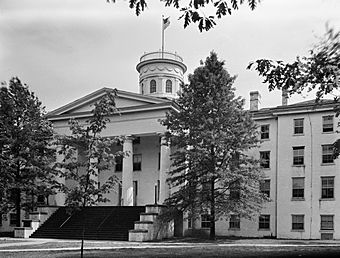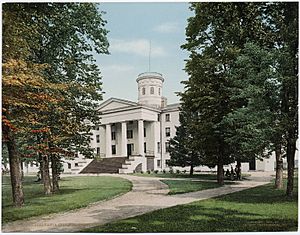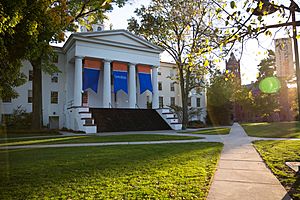Pennsylvania Hall (Gettysburg, Pennsylvania) facts for kids
Quick facts for kids |
|
|
Pennsylvania Hall, Gettysburg College
|
|

Front of Pennsylvania Hall
|
|
| Location | Gettysburg College campus, Gettysburg, Pennsylvania |
|---|---|
| Area | 1 acre (0.40 ha) |
| Built | 1837 |
| Architectural style | Greek Revival |
| NRHP reference No. | 72001087 |
| Added to NRHP | March 16, 1972 |
Pennsylvania Hall, also known as Penn Hall or Old Dorm, is a very important building at Gettysburg College. It's the main office building and the oldest building on campus. Built in 1838, it was designed in 1835 by John Cresson Trautwine. The building looks like an ancient Greek temple, with four tall columns at its entrance.
During the famous Battle of Gettysburg in July 1863, Pennsylvania Hall became a hospital. It helped care for soldiers who were hurt from both the Union and Confederate sides. Today, students still use the building for special events, like when they first join the college and when they graduate.
Contents
The Story of Pennsylvania Hall
The college we know as Gettysburg College started in 1832. Back then, it was called "Pennsylvania College of Gettysburg." It shared a building with another school, the Gettysburg Theological Seminary.
Later, the college bought about 6 acres of land from a person named Thaddeus Stevens. This is where Pennsylvania Hall was built. It was a big building with four floors. For many years, it was the only main academic building on campus.
In its early days, Pennsylvania Hall was a busy place. Students lived there, and it also had offices and classrooms. When the Battle of Gettysburg happened, it was the largest building in the whole town! The inside of the hall was updated in 1869 and 1870.
Pennsylvania Hall During the Battle of Gettysburg
The American Civil War brought a lot of changes to Gettysburg. On June 30, 1863, Union signal officers used the tall cupola (a small dome-like structure on the roof) of Old Dorm. They used it to send signals and watch the area.
On July 1, a professor named Michael Jacobs, who taught chemistry and math, took Union officers up to the cupola. From there, they could see the battlefield and what was happening.
After the battle, Pennsylvania Hall became a hospital for wounded soldiers. Around 700 soldiers were treated there until late July. Sadly, many soldiers died inside the building or on the land around it. Both Union and Confederate soldiers were cared for in the hall. This happened because control of the college changed hands between the armies on July 1.
Union soldiers who died nearby were later moved to the Gettysburg National Cemetery. Confederate soldiers were moved to cemeteries in the South, like Hollywood Cemetery (Richmond, Virginia).
Classes at Pennsylvania College started again on September 24, 1863. For many years after the battle, people still found bullets, bones, and bloody books in and around the building. It was a powerful reminder of the battle.
After the War: Updates and Recognition
Pennsylvania Hall was updated inside again in 1889 and 1928. In 1932, a special plaque was put up in Old Dorm. The building was also used as a main hospital during a big reunion of Civil War veterans in 1938.
In 1969, a major renovation began to make sure the building's walls, roof, and cupola were strong. Workers added steel columns and concrete floors. During this work, they found many interesting historical items hidden in the walls and under the floors!
Because of its important history, Pennsylvania Hall was added to the National Register of Historic Places in 1972. This list recognizes places that are important to the history of the United States.
What Pennsylvania Hall Is Used For Today
Today, Pennsylvania Hall is still a very important building at Gettysburg College. It holds the main offices for the college's leaders. The offices of the college president and provost (a high-ranking academic officer) are located here. You can also find the human resources and financial services departments in this historic building.
Images for kids





